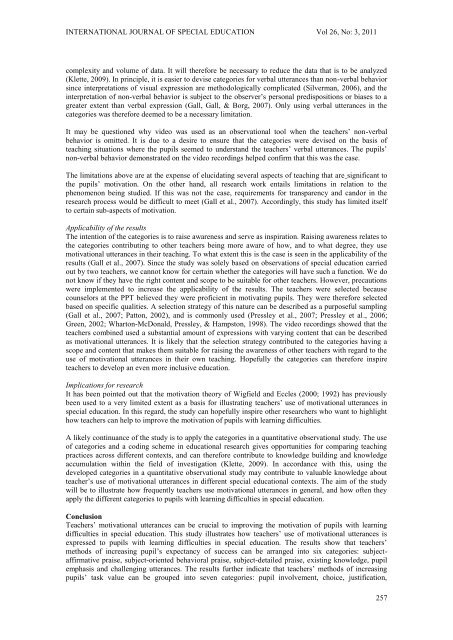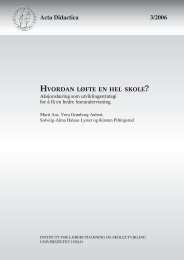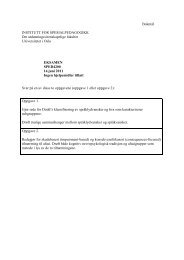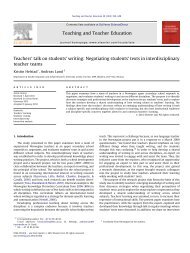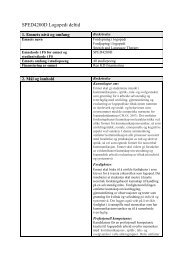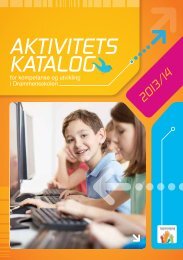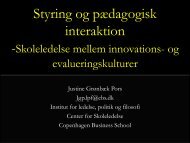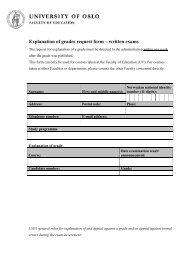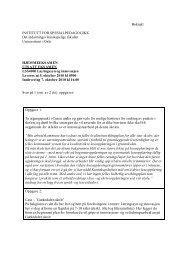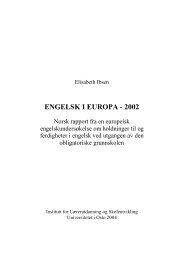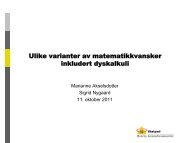International Journal Special Education
International Journal Special Education
International Journal Special Education
Create successful ePaper yourself
Turn your PDF publications into a flip-book with our unique Google optimized e-Paper software.
INTERNATIONAL JOURNAL OF SPECIAL EDUCATION Vol 26, No: 3, 2011complexity and volume of data. It will therefore be necessary to reduce the data that is to be analyzed(Klette, 2009). In principle, it is easier to devise categories for verbal utterances than non-verbal behaviorsince interpretations of visual expression are methodologically complicated (Silverman, 2006), and theinterpretation of non-verbal behavior is subject to the observer’s personal predispositions or biases to agreater extent than verbal expression (Gall, Gall, & Borg, 2007). Only using verbal utterances in thecategories was therefore deemed to be a necessary limitation.It may be questioned why video was used as an observational tool when the teachers’ non-verbalbehavior is omitted. It is due to a desire to ensure that the categories were devised on the basis ofteaching situations where the pupils seemed to understand the teachers’ verbal utterances. The pupils’non-verbal behavior demonstrated on the video recordings helped confirm that this was the case.The limitations above are at the expense of elucidating several aspects of teaching that are significant tothe pupils’ motivation. On the other hand, all research work entails limitations in relation to thephenomenon being studied. If this was not the case, requirements for transparency and candor in theresearch process would be difficult to meet (Gall et al., 2007). Accordingly, this study has limited itselfto certain sub-aspects of motivation.Applicability of the resultsThe intention of the categories is to raise awareness and serve as inspiration. Raising awareness relates tothe categories contributing to other teachers being more aware of how, and to what degree, they usemotivational utterances in their teaching. To what extent this is the case is seen in the applicability of theresults (Gall et al., 2007). Since the study was solely based on observations of special education carriedout by two teachers, we cannot know for certain whether the categories will have such a function. We donot know if they have the right content and scope to be suitable for other teachers. However, precautionswere implemented to increase the applicability of the results. The teachers were selected becausecounselors at the PPT believed they were proficient in motivating pupils. They were therefore selectedbased on specific qualities. A selection strategy of this nature can be described as a purposeful sampling(Gall et al., 2007; Patton, 2002), and is commonly used (Pressley et al., 2007; Pressley et al., 2006;Green, 2002; Wharton-McDonald, Pressley, & Hampston, 1998). The video recordings showed that theteachers combined used a substantial amount of expressions with varying content that can be describedas motivational utterances. It is likely that the selection strategy contributed to the categories having ascope and content that makes them suitable for raising the awareness of other teachers with regard to theuse of motivational utterances in their own teaching. Hopefully the categories can therefore inspireteachers to develop an even more inclusive education.Implications for researchIt has been pointed out that the motivation theory of Wigfield and Eccles (2000; 1992) has previouslybeen used to a very limited extent as a basis for illustrating teachers’ use of motivational utterances inspecial education. In this regard, the study can hopefully inspire other researchers who want to highlighthow teachers can help to improve the motivation of pupils with learning difficulties.A likely continuance of the study is to apply the categories in a quantitative observational study. The useof categories and a coding scheme in educational research gives opportunities for comparing teachingpractices across different contexts, and can therefore contribute to knowledge building and knowledgeaccumulation within the field of investigation (Klette, 2009). In accordance with this, using thedeveloped categories in a quantitative observational study may contribute to valuable knowledge aboutteacher’s use of motivational utterances in different special educational contexts. The aim of the studywill be to illustrate how frequently teachers use motivational utterances in general, and how often theyapply the different categories to pupils with learning difficulties in special education.ConclusionTeachers’ motivational utterances can be crucial to improving the motivation of pupils with learningdifficulties in special education. This study illustrates how teachers’ use of motivational utterances isexpressed to pupils with learning difficulties in special education. The results show that teachers’methods of increasing pupil’s expectancy of success can be arranged into six categories: subjectaffirmativepraise, subject-oriented behavioral praise, subject-detailed praise, existing knowledge, pupilemphasis and challenging utterances. The results further indicate that teachers’ methods of increasingpupils’ task value can be grouped into seven categories: pupil involvement, choice, justification,257


